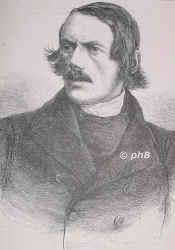Carl Hasenpflug
Georg Carl Adolph Hasenpflug (born September 23, 1802 in Berlin , † April 13, 1858 in Halberstadt ) was a German painter .
Life
Like his father, Carl Hasenpflug first learned the trade of shoemaker. In 1820, however, he was able to begin an apprenticeship as a decorative painter in the workshop of Carl Wilhelm Gropius in Berlin . He also had contact with Karl Friedrich Schinkel, who worked there . Hasenpflug then devoted himself increasingly to architectural painting and occasionally visited - with the support of Friedrich Wilhelm III. - the Berlin Academy .
Hasenpflug first went from Berlin to Leipzig . From 1830, however, he lived and worked in Halberstadt. Hasenpflug became a painter in great demand due to his detailed and authentic architectural paintings. The focus of his work, which was often commissioned, was in particular church buildings. He painted the cathedrals of Magdeburg , Erfurt , Halberstadt and Brandenburg an der Havel .
From 1832 to 1836 Hasenpflug worked on an order in Cologne and met Carl Friedrich Lessing . Hasenpflug received suggestions from Lessing which led him to detach himself from the realistic, sober depiction of architecture that was cultivated in Berlin and to pursue a romantic, transfigured style in the sense of the Düsseldorf school . As a result, many works were created with, often wintry, motifs, such as ruins and chapels.
Hasenpflug, along with Eduard Gaertner , Johann Erdmann Hummel and Johann Heinrich Hintze, was one of the most important German architectural painters of his time.
The city of Magdeburg named Hasenpflugstrasse in his honor. There is also a street of the same name in Halberstadt .
Works

- The Cathedral Church in Berlin, 1825, oil on canvas, 58.5 × 76 cm, Märkisches Museum Berlin. The painting shows the old Berlin Cathedral, built around the middle of the 18th century according to plans by Johann Boumann the Elder, later redesigned by Karl Friedrich Schinkel, which was demolished in 1890. (Picture in gallery)
- The Erfurt Cathedral , 1826
- The Potsdam Garrison Church , 1827
- Erfurt Cathedral, 1827
- The rood screen in Halberstadt Cathedral , 1828
- The Magdeburg Cathedral from the northeast, 1828
- Magdeburg in the destruction of May 10, 1631, 1831
- Magdeburg in the prime of May 10, 1831, 1831
- Halberstadt Cathedral, 1834
- Cologne Cathedral , 1832–1836
- Halberstadt Cathedral, 1836
- Magdeburg view from the northeast, 1836
- West facade of Magdeburg Cathedral, 1837
- Heisterbach choir ruin, 1840 (oil painting of the Heisterbach monastery ) also attributed to Bernhard Höfling .
- Convent in winter, 1840
- View of the cemetery in winter, 1841
- Walkenried monastery ruins , 1842
- From the cloister of the Church of Our Lady in Halberstadt, 1843
- Monastery ruins in winter, 1845
- Monastery ruins in winter, 1847
- View of the church ruins in Halberstadt in winter, 1847
- Falkenstein castle ruins in the Harz Mountains in winter, 1847
- Monastery ruins in winter (Walkenried Monastery), 1850, Lower Saxony State Museum Hanover
- Convent walk in the snow, 1854
- Saaleck castle ruins , 1857
gallery
Magdeburg , city view from the southeast, 1831
Ideal view of Cologne Cathedral , 1834–1836
Walkenried Monastery / Harz , 1842
literature
- Robert Dohme: Hasenpflug, Karl Georg Adolf . In: Allgemeine Deutsche Biographie (ADB). Volume 10, Duncker & Humblot, Leipzig 1879, p. 740.
- Sabine Liebscher: Hasenpflug, Georg Carl Adolph. In: Guido Heinrich, Gunter Schandera (ed.): Magdeburg Biographical Lexicon 19th and 20th centuries. Biographical lexicon for the state capital Magdeburg and the districts of Bördekreis, Jerichower Land, Ohrekreis and Schönebeck. Scriptum, Magdeburg 2002, ISBN 3-933046-49-1 .
- Antje Ziehr: Carl Hasenpflug - sketchbook from 1831 , Städtisches Museum Halberstadt 2003, ISBN 3-934245-03-X
- Irmgard Wirth: Hasenpflug, George Carl Adolph. In: New German Biography (NDB). Volume 8, Duncker & Humblot, Berlin 1969, ISBN 3-428-00189-3 , p. 35 ( digitized version ).
- Antje Ziehr: Carl Hasenpflug - Truth and Vision , exhibition for the 200th birthday, Städtisches Museum Halberstadt 2002, ISBN 3-934245-02-1
- Antje Ziehr: Carl Hasenpflug between Berlin, Halberstadt and Vienna. Travel letters from 1842, Hasenpflug and his copyists, Halberstadt 2015, ISBN 978-3-934245-06-8
Web links
- Literature by and about Carl Hasenpflug in the catalog of the German National Library
- Works by Carl Hasenpflug on museum-digital.de
Individual evidence
| personal data | |
|---|---|
| SURNAME | Hare plow, Carl |
| ALTERNATIVE NAMES | Hasenpflug, Georg Carl Adolph (full name) |
| BRIEF DESCRIPTION | German painter |
| DATE OF BIRTH | September 23, 1802 |
| PLACE OF BIRTH | Berlin |
| DATE OF DEATH | April 13, 1858 |
| Place of death | Halberstadt |











